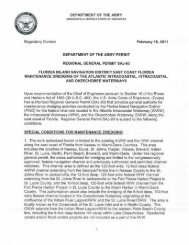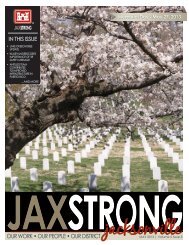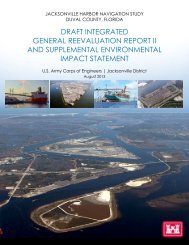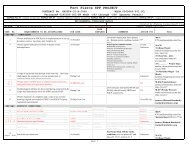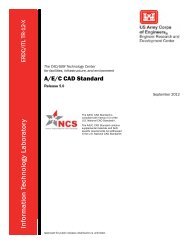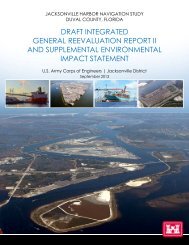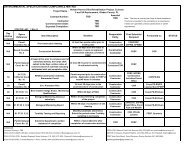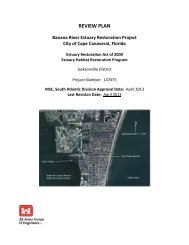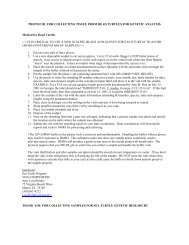SAJ-91 - Jacksonville District - U.S. Army
SAJ-91 - Jacksonville District - U.S. Army
SAJ-91 - Jacksonville District - U.S. Army
You also want an ePaper? Increase the reach of your titles
YUMPU automatically turns print PDFs into web optimized ePapers that Google loves.
DEPARTMENT OF THE ARMY<br />
JACKSONVILLE DISTRICT CORPS OF ENGINEERS<br />
P. O. BOX 4970<br />
JACKSONVILLE, FLORIDA 32232-0019<br />
REPLY TO<br />
ATTENTION OF<br />
Regulatory Division<br />
FEB 28 2013<br />
DEPARTMENT OF THE ARMY<br />
PROGRAMMATIC GENERAL PERMIT <strong>SAJ</strong>-<strong>91</strong><br />
<strong>SAJ</strong>-2005-08775(KDS)<br />
BULKHEADS AND BACKFILL, AERIAL TRANSMISSION LINES, SUBAQUEOUS<br />
UTILITY AND TRANSMISSION LINES, PRIVATE SINGLE-FAMILY PIERS AND<br />
APPURTENANCES, OTHER MINOR STRUCTURES ASSOCIATED WITH SINGLE-<br />
FAMILY DOCKS, AND STORMWATER OUTFALLS LOCATED WITHIN THE CITY<br />
OF CAPE CORAL, LEE COUNTY, FLORIDA.<br />
Upon recommendation of the Chief of Engineers, pursuant to Section 10 of the Rivers and<br />
Harbors Act of 1899 and Section 404 of the Clean Water Act, general authority is hereby given<br />
to the City of Cape Coral to administer this permit for the construction of bulkheads and backfill,<br />
aerial transmission lines, subaqueous utility and transmission lines, private single-family piers<br />
and appurtenances, other minor structures associated with single-family docks, and storm water<br />
outfalls located in waters of the United States within the City of Cape Coral, Lee County,<br />
Florida. This permit does not authorize any work or structure along the Caloosahatchee<br />
River, Matlacha Pass Aquatic Preseve or within the Cape Coral Spreader Waterways.<br />
This programmatic general permit is subject to the following conditions:<br />
A. CONDITIONS FOR BULKHEADS AND BACKFILL IN RESIDENTIAL CANALS<br />
1. The work herein authorized includes the construction, repair or maintenance of seawalls<br />
(bulkheads) and associated backfill in residential canals.<br />
2. The seawall shall not exceed 300 feet in length and not extend any farther waterward than 18<br />
inches from the existing seawall or Mean High Water Line (MHWL).<br />
3. The backfill must be from upland sources and consist of suitable clean fill material free from<br />
toxic pollutants in other than trace quantities. The amount of backfill shall not exceed one (1)<br />
cubic yard per running foot below the plane of the MHWL.<br />
4. This permit does not authorize any filling, except for backfill behind the seawall. New riprap<br />
may be placed at the toe of the existing or replacement seawall when the toe of the seawall is<br />
deeper than 3 feet at Mean Lower Low Water (MLLW). Also, replacement riprap can only be<br />
added within the same footprint of existing riprap (i.e. no waterward expansion or lateral
expansion of riprap beyond the previous footprint) in depths less than or equal to 3 feet at<br />
MLLW.<br />
5. The removal of mangroves is prohibited.<br />
6. In addition to the above conditions, the permittee must abide by all of the Special Conditions<br />
listed below and the attached General Conditions. These Special and General Conditions are<br />
applicable to all structures and/or work authorized under this general permit.<br />
B. CONDITIONS FOR AERIAL TRANSMISSION LINES:<br />
1. The work herein authorized includes the installation of aerial transmission lines and<br />
associated structures.<br />
2. The aerial transmission lines must meet the U.S. <strong>Army</strong> Corps of Engineers clearance criteria<br />
as described in 33 CFR, Part 322.5(i)(1), (2), (3), and (4).<br />
3. The construction of aerial transmission lines does not involve the dredging or filling of<br />
navigable waters or waters of the United States. All work will be conducted from uplands.<br />
4. The permittee shall defend and hold the U.S. Government harmless from any and all claims<br />
by reason of the placement and installation of the transmission lines authorized by this permit.<br />
5. In addition to the above conditions, the permittee must abide by all of the Special Conditions<br />
listed below and the attached General Conditions. These Special and General Conditions are<br />
applicable to all structures and/or work authorized under this general permit.<br />
C. CONDITIONS FOR SUBAQUEOUS AND TRANSMISSION LINES:<br />
1. The work herein authorized includes the installation and maintenance of subaqueous utility<br />
and transmission lines placed on, under or embedded in the bottom of navigable waters of the<br />
United States within the City of Cape Coral. The installation of utility and transmission lines by<br />
directional bore is authorized. Directional drilling used for subaqueous transmission lines will be<br />
restricted to drilling from the uplands only.<br />
2. Dredged or fill material placed as backfill or bedding for subaqueous utility and transmission<br />
lines must not change the preconstruction bottom contours. Excess material must be removed to<br />
an upland disposal area.<br />
3. The permittee will install signs at the shoreline to notify navigational interests of the location<br />
of subaqueous utility and transmission lines.<br />
4. The permittee shall defend and hold the U.S. Government harmless from any and all claims<br />
by reason of the placement and installation of the transmission lines authorized by this permit.<br />
2
5. In addition to the above conditions, the permittee must abide by all of the Special Conditions<br />
listed below and the attached General Conditions. These Special and General Conditions are<br />
applicable to all structures and/or work authorized under this general permit.<br />
D. CONDITIONS FOR PRIVATE SINGLE-FAMILY DOCKS AND APPURTENANCES:<br />
1. Structures authorized under this general permit are private single-family piers not to exceed 4<br />
slips. This would include normal appurtenances such as boat hoists, boat shelters with open<br />
sides, stairways, walkways, mooring piles, dolphins, and maintenance of these appurtenances.<br />
Upland-cut boat slips are not authorized by this general permit.<br />
2. No living, fueling, or storage facilities over navigable waters of the United States are<br />
authorized under this general permit.<br />
3. The structure shall be consistent with other structures in the area.<br />
4. Where practicable, unless sealed or wrapped, the use of CCA-treated wood should be<br />
avoided.<br />
5. A structure which by its size or location may adversely affect water quality, fish and wildlife<br />
habitat, wetlands or submerged aquatic vegetation shall not be authorized by this general permit.<br />
Impacts to submerged aquatic vegetation cannot be authorized by <strong>SAJ</strong>-<strong>91</strong>.<br />
6. No activity may cause more than a minimal adverse effect on navigation. Any safety lights<br />
and signals prescribed by the U.S. Coast Guard, through regulations or otherwise, must be<br />
installed and maintained at the permittee’s expense on authorized facilities in navigable waters of<br />
the United States.<br />
7. In addition to the above conditions, the permittee must abide by all of the Special Conditions<br />
listed below and the attached General Conditions. These Special and General Conditions are<br />
applicable to all structures and/or work authorized under this general permit.<br />
E. CONDITIONS FOR MINOR STRUCTURES ASSOCIATED WITH SINGLE-FAMILY<br />
DOCKS:<br />
1. The work herein authorized will be for minor structures to include:<br />
a. Single mooring piles;<br />
b. Small mooring dolphins (limited to one cluster of 4 or fewer<br />
pilings);<br />
c. Non-commercial information signage;<br />
d. Boat lifts, hoists, davits; and,<br />
3
e. Other minor structures that would have less environmental impact than<br />
a small dock.<br />
2. Where practicable, unless sealed, or wrapped, the use of CCA-treated wood should be<br />
avoided.<br />
3. The structure shall be consistent with other structures in the area.<br />
5. A structure which by its size or location may adversely affect water quality, fish and wildlife<br />
habitat, wetlands or submerged aquatic vegetation shall not be authorized by this general permit.<br />
Impacts to submerged aquatic vegetation cannot be authorized by <strong>SAJ</strong>-<strong>91</strong>.<br />
6. No activity may cause more than a minimal adverse effect on navigation. Any safety lights<br />
and signals prescribed by the U.S. Coast Guard, through regulations or otherwise, must be<br />
installed and maintained at the permittee’s expense on authorized facilities in navigable waters of<br />
the United States.<br />
3. In addition to the above conditions, the permittee must abide by all of the Special Conditions<br />
listed below and the attached General Conditions. These Special and General Conditions are<br />
applicable to all structures and/or work authorized under this general permit.<br />
F. CONDITIONS FOR STORM WATER OUTFALLS:<br />
1. Structures authorized under this general permit are storm water outfalls and appurtenances.<br />
2. Authorization is contingent upon issuance of lawfully required National Pollutant Discharge<br />
Elimination System permits (Section 402 of the Clean Water Act) from the U.S. Environmental<br />
Protection Agency, Florida Department of Environmental Protection, State Water Management<br />
<strong>District</strong>, or their legally authorized delegate.<br />
3. This general permit authorizes dredging at storm water outfalls. Maintenance dredging shall<br />
be limited to a depth of no more than 5 feet below mean or ordinary high water. No additional<br />
dredging is authorized under this general permit other than that which would be necessary to<br />
restore the discharge structure to its original permitted excavated depth.<br />
4. Excavated spoil material shall be deposited at self-contained upland areas that will prevent<br />
spoil material and/or return water from reentering any water of the United States (including<br />
wetlands) or interfering with natural drainage.<br />
5. In canals with open access to the Caloosahatchee River or Matlacha Pass Aquatic Preserve,<br />
grating shall be installed over the outfall to reduce the risk of entrapment and drowning of<br />
manatees. Grating shall be installed over pipes greater than eight 8 inches, but smaller than 8<br />
feet in diameter. Bars or grates no more than 8 inches apart shall be placed on the accessible<br />
end(s) to restrict manatee access. For new culverts, grates must be attached prior to installation<br />
of the culverts. The installation of grates applies to submerged or partially submerged pipes and<br />
culverts reasonably accessible to manatees.<br />
4
6. In addition to the above conditions, the permittee must abide by all of the Special Conditions<br />
listed below and the attached General Conditions. These Special and General Conditions are<br />
applicable to all structures and/or work authorized under this general permit.<br />
G. SPECIAL CONDITIONS FOR ALL WORK:<br />
1. No work shall be performed until the permittee submits satisfactory plans for the proposed<br />
activity and receives written authorization from the City of Cape Coral.<br />
2. The work authorized herein is limited to existing canals within the City of Cape Coral and<br />
does not include the Caloosahatchee River, Matlacha Pass Aquatic Preserve, and the Cape Coral<br />
Spreader Waterways.<br />
3. No activity shall be authorized under this general permit that may adversely affect water<br />
quality, fish and wildlife habitat, wetlands, or emergent or submerged aquatic vegetation.<br />
4. No work shall be performed until after the permittee provides notification to the owner(s) or<br />
operator(s) of any marked utilities in the work area.<br />
5. Cultural Resources/Historic Properties:<br />
a. No structure or work shall adversely affect impact or disturb properties listed in the National<br />
Register of Historic Places (NRHP) or those eligible for inclusion in the NRHP.<br />
b. If during the ground disturbing activities and construction work within the permit area, there<br />
are archaeological/cultural materials encountered which were not the subject of a previous<br />
cultural resources assessment survey (and which shall include, but not be limited to: pottery,<br />
modified shell, flora, fauna, human remains, ceramics, stone tools or metal implements, dugout<br />
canoes, evidence of structures or any other physical remains that could be associated with Native<br />
American cultures or early colonial or American settlement), the Permittee shall immediately<br />
stop all work in the vicinity and notify the Corps. The Corps shall then notify the Florida State<br />
Historic Preservation Officer (SHPO) and the appropriate Tribal Historic Preservation Officer(s)<br />
(THPO(s)) to assess the significance of the discovery and devise appropriate actions.<br />
c. A cultural resources assessment may be required of the permit area, if deemed necessary by<br />
the SHPO, THPO(s), or Corps, in accordance with 36 CFR 800 or 33 CFR 325, Appendix C (5).<br />
Based, on the circumstances of the discovery, equity to all parties, and considerations of the<br />
public interest, the Corps may modify, suspend or revoke the permit in accordance with 33 CFR<br />
Part 325.7. Such activity shall not resume on non-federal lands without written authorization<br />
from the SHPO and the Corps.<br />
d. In the unlikely event that unmarked human remains are identified on non-federal lands, they<br />
will be treated in accordance with Section 872.05 Florida Statutes. All work in the vicinity shall<br />
immediately cease and the Permittee shall immediately notify the medical examiner, Corps, and<br />
State Archeologist. The Corps shall then notify the appropriate SHPO and THPO(s). Based, on<br />
5
the circumstances of the discovery, equity to all parties, and considerations of the public interest,<br />
the Corps may modify, suspend or revoke the permit in accordance with 33 CFR Part 325.7.<br />
Such activity shall not resume without written authorization from the State Archeologist, SHPO<br />
and the Corps.<br />
e. In the unlikely event that human remains are encountered on federal or tribal lands, or in<br />
situations where Archaeological Resources Protection Act of 1979, or Native American Graves<br />
Protection Repatriation Act of 1990 applies, all work in the vicinity shall immediately cease and<br />
the Permittee immediately notify the Corps. The Corps shall then notify the appropriate THPO(s)<br />
and SHPO. Based, on the circumstances of the discovery, equity to all parties, and considerations<br />
of the public interest, the Corps may modify, suspend or revoke the permit in accordance with 33<br />
CFR Part 325.7. After such notification, project activities on federal lands shall not resume<br />
without written authorization from the Corps, and/or appropriate THPO(s), SHPO, and federal<br />
manager. After such notification, project activities on tribal lands shall not resume without<br />
written authorization from the appropriate THPO(s) and the Corps.<br />
6. Conformance with descriptions and quantities contained herein does not necessarily guarantee<br />
authorization under this general permit and the <strong>District</strong> Engineer reserves the right to evaluate<br />
any proposed work in waters of the United States as a Standard Permit.<br />
7. Any structure or work authorized under this general permit must not interfere with general<br />
navigation.<br />
8. Projects proposing installation of any type of piling greater than 24 inches in diameter, or<br />
installation of any size of metal piling or sheet piling by impact hammer cannot be authorized<br />
under <strong>SAJ</strong>-<strong>91</strong>.<br />
9. Projects proposing installation of any type or size of piling or sheet piling by impact hammer<br />
cannot be authorized under <strong>SAJ</strong>-<strong>91</strong> during the period March 1 through June 30 in the noise<br />
restriction areas as contained within the polygons described by the latitudinal/longitudinal<br />
coordinates listed in Appendix 1 and shown in Appendix 2.<br />
10. In canals with open, lift, or lock access to the Caloosahatchee River or Matlacha Pass<br />
Aquatic Preserve, prior to verification of authorization, the dichotomous key entitled “The Corps<br />
of Engineers, <strong>Jacksonville</strong> <strong>District</strong>, and the State of Florida Effect Determination Key for the<br />
Manatee in Florida – March 2011”, will be used to determine potential manatee impacts.<br />
Projects determined to be a “may affect” or “may affect, not likely to adversely affect” further<br />
consultation with U.S. Fish and Wildlife Service is required are not authorized by this general<br />
permit and will be coordinated with the U.S. Fish and Wildlife Service by the Corps in<br />
accordance with the Endangered Species Act. Projects determined to be “may affect not likely<br />
to adversely affect” no further consultation required must follow all additional, specific<br />
conditions related to the pertinent activities as outlined in the Key and its associated maps. Note:<br />
The manatee key may be subject to revision at any time. It is our intention that the most recent version of this<br />
technical tool will be utilized during the evaluation of the permit application.<br />
11. In canals with open, lift, or lock access to the Caloosahatchee River or Matlacha Pass<br />
Aquatic Preserve, the permittee will utilize the “Standard Manatee Conditions for In-Water<br />
6
Work, 2011” (see<br />
http://www.saj.usace.army.mil/Portals/44/docs/regulatory/sourcebook/endangered_species/Mana<br />
tee/20110321_Manatee_Key_Final_with_modifications_for_PBO.pdf).<br />
12. In canals with open, lift, or lock access to the Caloosahatchee River or Matlacha Pass<br />
Aquatic Preserve, the permittee will utilize the “Sea Turtle and Smalltooth Sawfish Construction<br />
Conditions” see<br />
(http://www.saj.usace.army.mil/Portals/44/docs/regulatory/sourcebook/endangered_species/sea_t<br />
urtles/inwaterWorkSeaTurtle032306.pdf) and/or requirements, as appropriate for the proposed<br />
activity. Note: These conditions may be subject to revision at any time. It is our intention that the most recent<br />
version of this technical tool will be utilized during the evaluation of the permit application.<br />
13. Turbidity control measures will be used to control water quality and the work must be in<br />
accordance with State Water Quality Standards as outlined in Florida Statute 62-302. Turbidity<br />
control measures may include but are not limited to, turbidity control curtains, the exclusive use<br />
of suction dredging, the exclusive use of closed “clam shell” dredging, or any other technique<br />
necessary to reduce turbidity to no more than background turbidity. The Florida Department of<br />
Environmental Protection (FDEP) may require the applicant to submit a daily turbidity report<br />
which may be verified by state or local government inspectors.<br />
14. No activity shall be authorized under this general permit which is likely to adversely affect a<br />
Federally-listed threatened or endangered species or a species proposed for such designation, or<br />
destroy or adversely modify its designated critical habitat.<br />
15. Activities qualifying for this programmatic general permit (PGP) must be authorized by the<br />
applicable permit or exemption under Part IV of Chapter 373, F.S., and by any authorization<br />
required to use or occupy state-owned submerged lands (SSL) under Chapter 253, F.S., and, as<br />
applicable Chapter 258 F.S. Such permit, issued by the Department of Environmental<br />
Protection, a water management district under s. 373.069, F.S., or a local government with<br />
delegated authority under s. 373.441, F.S., will provide the applicable Water Quality<br />
Certification (WQC) or waiver thereto, and Coastal Zone Consistency Concurrence (CZCC).<br />
WQC is waived for activities authorized under this PGP that qualify for an exemption under s.<br />
403.813(1) or 373.406, F.S., or the rules of Florida Administrative Code (F.A.C.) adopted under<br />
Part IV of Chapter 373, F.S. The Corps, or any designated Federal, State, or local agency<br />
administering general permits on behalf of the Corps under C.F.R. § 325.2(b)(2) may presume<br />
CZCC for the above exempt activities by operation of s. 380.23(7), F.S., provided the activity<br />
receives the applicable authorization to use and occupy SSL under Chapter 253, F.S., and, as<br />
applicable, Chapter 258, F.S., and the rules F.A.C. adopted thereunder. The Corps, or any<br />
designated Federal, State, or local agency administering general permits on behalf of the Corps<br />
under shall not be precluded from acting on a request to use this PGP before the applicable SSL<br />
authorization is granted.<br />
16. This PGP does not include conditions that would prevent the ‘take’ of a state-listed fish or<br />
wildlife species. These species are protected under sec. 379.411, Florida Statutes, and listed<br />
under Rule 68A-27, Florida Administrative Code. With regard to fish and wildlife species<br />
designated as species of special concern or threatened by the State of Florida, you are responsible<br />
for coordinating directly with the Florida Fish and Wildlife Conservation Commission (FWC).<br />
7
You can visit the FWC license and permitting webpage<br />
(http://www.myfwc.com/license/wildlife/) for more information, including a list of those fish and<br />
wildlife species designated as species of special concern or threatened. The Florida Natural<br />
Areas Inventory (http://www.fnai.org/) also maintains updated lists, by county, of documented<br />
occurrences of those species.<br />
16. For projects authorized under this permit in navigable waters of the U.S., the permittee<br />
understands and agrees that, if future operations by the United States require the removal,<br />
relocation, or other alteration, of the structures or work herein authorized, or if, in the opinion of<br />
the Secretary of the <strong>Army</strong> or his authorized representative, said structure or work shall cause<br />
unreasonable obstruction to the free navigation of the navigable waters, the permittee will be<br />
required, upon due notice from the Corps of Engineers, to remove, relocate, or alter the structural<br />
work or obstructions caused thereby, without expense to the United States. No claim shall be<br />
made against the United States on account of any such removal or alteration.<br />
17. This programmatic general permit will be valid for a period of 5 years from the date<br />
specified above unless suspended or revoked by the <strong>District</strong> Engineer prior to that date. If <strong>SAJ</strong>-<br />
<strong>91</strong> expires or is revoked prior to completion of the authorized work, authorization of activities<br />
that have commenced or are under contract to commence in reliance on <strong>SAJ</strong>-<strong>91</strong> will remain in<br />
effect provided the activity is completed with 12 months ofthe date <strong>SAJ</strong>-<strong>91</strong> expired or was<br />
revoked.<br />
18. The General conditions attached hereto are made a part of this permit and must be attached<br />
to all authorizations processed under this permit.<br />
BY AUTHORITY OF THE SECRETARY OF THE ARMY:<br />
d:IJfa/<br />
Alan M. Dodd,<br />
Colonel, U.S. <strong>Army</strong><br />
<strong>District</strong> Commander<br />
8
GENERAL CONDITIONS<br />
1. The time limit for completing the work authorized ends on February 28, 2018.<br />
2. You must maintain the activity authorized by this permit in good condition and in<br />
conformance with the terms and conditions of this permit. You are not relieved of this<br />
requirement if you abandon the permitted activity, although you may make a good faith transfer<br />
to a third party in compliance with General Condition 4 below. Should you wish to cease to<br />
maintain the authorized activity or should you desire to abandon it without a good faith transfer,<br />
you must obtain a modification of this permit from this office, which may require restoration of<br />
the area.<br />
3. If you discover any previously unknown historic or archeological remains while<br />
accomplishing the activity authorized by this permit, you must immediately notify this office of<br />
what you have found. We will initiate the Federal and state coordination required to determine if<br />
the remains warrant a recovery effort of if the site is eligible for listing in the National Register<br />
of Historic Places.<br />
4. If you sell the property associated with this permit you must obtain the signature of the new<br />
owner in the space provided and forward a copy of the permit to the Fort Myers Regulatory<br />
Office at 1520 Royal Palm Square Boulevard, Suite 310, Fort Myers, Florida 33<strong>91</strong>9 to validate<br />
the transfer of this authorization.<br />
5. If a conditioned water quality certification has been issued for your project, you must comply<br />
with the conditions specified in the certification as special conditions to this permit. For your<br />
convenience, a copy of the certification is attached if it contains such conditions.<br />
6. You must allow a representative from the Corps or its delegated authority to inspect the<br />
authorized activity at any time deemed necessary to ensure that it is being or has been<br />
accomplished in accordance with the terms and conditions of your permit.<br />
Further Information:<br />
1. Congressional Authorities: You have been authorized to undertake the activity described<br />
above pursuant to:<br />
(X) Section 10 of the Rivers and Harbors Act of 1899 (33 U.S.C. 403).<br />
(X) Section 404 of the Clean Water Act (33 U.S.C. 1344).<br />
( ) Section 103 of the Marine Protection, Research and Sanctuaries Act of 1972 (33 U.S.C.<br />
1413).<br />
2. Limits of this authorization.<br />
a. This permit does not obviate the need to obtain other Federal, State, or local authorizations<br />
required by law.<br />
9
. This permit does not grant any property rights or exclusive privileges.<br />
c. This permit does not authorize any injury to the property or rights of others.<br />
d. This permit does not authorize interference with any existing or proposed Federal<br />
projects.<br />
3. Limits of Federal Liability. In issuing this permit, the Federal Government does not assume<br />
any liability for the following:<br />
a. Damages to the permitted project or uses thereof as a result of other permitted or unpermitted<br />
activities or from natural causes.<br />
b. Damages to the permitted project or uses thereof as a result of current or future activities<br />
undertaken by or on behalf of the United States in the public interest.<br />
c. Damages to persons, property, or to other permitted or unpermitted activities or structures<br />
caused by the activity authorized by this permit.<br />
d. Design or construction deficiencies associated with the permitted work. e. Damage claims<br />
associated with any future modification, suspension, or<br />
revocation of this permit.<br />
4. Reliance on Applicant's Data: The determination of this office that issuance of this permit<br />
verification is not contrary to the public interest was made in reliance on the information you<br />
provided.<br />
5. Reevaluation of Permit Verification Decision: This office may reevaluate its decision on this<br />
permit verification at any time the circumstances warrant. Circumstances that could require a<br />
reevaluation include, but are not limited to, the following:<br />
a. You fail to comply with the terms and conditions of this permit.<br />
b. The information provided by you in support of your permit application proves to have been<br />
false, incomplete, or inaccurate (see 4 above).<br />
c. Significant new information surfaces which this office did not consider in reaching the<br />
original public interest decision.<br />
Such a reevaluation may result in a determination that it is appropriate to use the suspension,<br />
modification, and revocation procedures contained in 33 CFR 325.7 or enforcement procedures<br />
such as those contained in 33 CFR 326.4 and 326.5. The referenced enforcement procedures<br />
provide for the issuance of an administrative order requiring you comply with the terms and<br />
conditions of your permit and for the initiation of legal action where appropriate. You will be<br />
required to pay for any corrective measures ordered by this office, and if you fail to comply with<br />
such directive, this office may in certain situations (such as those specified .in 33 CFR 209.170)<br />
accomplish the corrective measures by contract or otherwise and bill you for the cost.<br />
10
North<br />
Map courtesy of<br />
www.capecoral.net<br />
<strong>SAJ</strong>-2005-08775(KDS)<br />
<strong>SAJ</strong>-<strong>91</strong><br />
Attachment 1<br />
Map of Cape Coral
Appendix 1: Noise restriction zones in smalltooth sawfish critical habitat.<br />
Name Latitude Longitude<br />
Cape Coral<br />
CC 1 26.551662° -81.947412°<br />
CC 2 26.551561° -81.940683°<br />
CC 3 26.539075° -81.940<strong>91</strong>6°<br />
CC 4 26.539205° -81.951049°<br />
CC 5 26.542181° -81.951047°<br />
CC 6 26.542133° -81.947776°<br />
<strong>SAJ</strong>-2005-08775(KDS)<br />
<strong>SAJ</strong>-<strong>91</strong><br />
Appendix 1
Appendix Appendix 5: Cape 2: Cape Coral Coral Canals Canals with with very very small small juvenile juvenile sawfish sawfish encounters encounters<br />
<strong>SAJ</strong>-2005-08775(KDS)<br />
<strong>SAJ</strong>-<strong>91</strong><br />
Appendix 2



